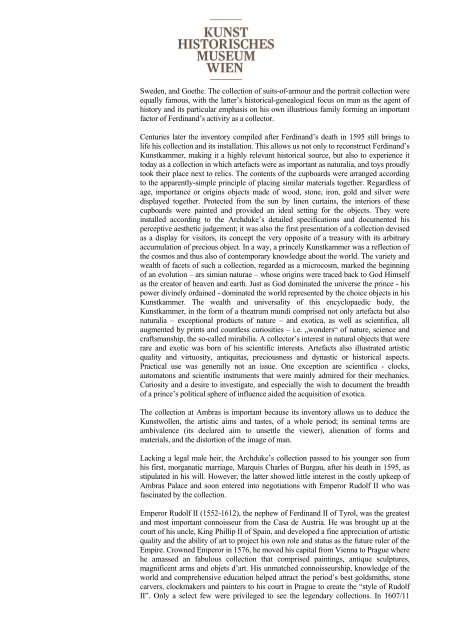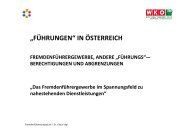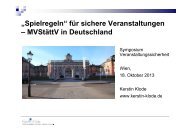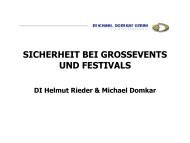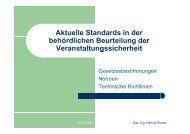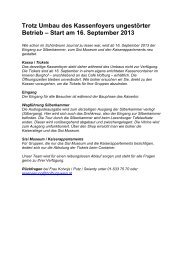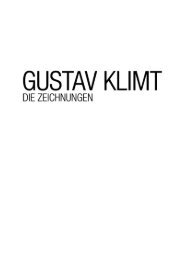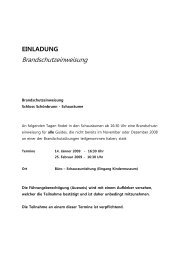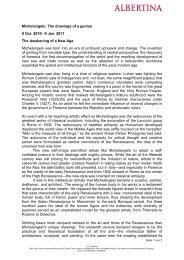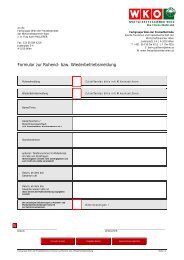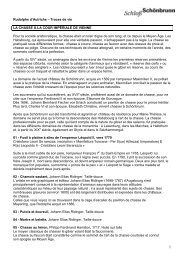kunstkammer vienna the cradle of the museum - Freizeitbetriebe ...
kunstkammer vienna the cradle of the museum - Freizeitbetriebe ...
kunstkammer vienna the cradle of the museum - Freizeitbetriebe ...
Create successful ePaper yourself
Turn your PDF publications into a flip-book with our unique Google optimized e-Paper software.
Sweden, and Goe<strong>the</strong>. The collection <strong>of</strong> suits-<strong>of</strong>-armour and <strong>the</strong> portrait collection were<br />
equally famous, with <strong>the</strong> latter’s historical-genealogical focus on man as <strong>the</strong> agent <strong>of</strong><br />
history and its particular emphasis on his own illustrious family forming an important<br />
factor <strong>of</strong> Ferdinand’s activity as a collector.<br />
Centuries later <strong>the</strong> inventory compiled after Ferdinand’s death in 1595 still brings to<br />
life his collection and its installation. This allows us not only to reconstruct Ferdinand’s<br />
Kunstkammer, making it a highly relevant historical source, but also to experience it<br />
today as a collection in which artefacts were as important as naturalia, and toys proudly<br />
took <strong>the</strong>ir place next to relics. The contents <strong>of</strong> <strong>the</strong> cupboards were arranged according<br />
to <strong>the</strong> apparently-simple principle <strong>of</strong> placing similar materials toge<strong>the</strong>r. Regardless <strong>of</strong><br />
age, importance or origins objects made <strong>of</strong> wood, stone, iron, gold and silver were<br />
displayed toge<strong>the</strong>r. Protected from <strong>the</strong> sun by linen curtains, <strong>the</strong> interiors <strong>of</strong> <strong>the</strong>se<br />
cupboards were painted and provided an ideal setting for <strong>the</strong> objects. They were<br />
installed according to <strong>the</strong> Archduke’s detailed specifications and documented his<br />
perceptive aes<strong>the</strong>tic judgement; it was also <strong>the</strong> first presentation <strong>of</strong> a collection devised<br />
as a display for visitors, its concept <strong>the</strong> very opposite <strong>of</strong> a treasury with its arbitrary<br />
accumulation <strong>of</strong> precious object. In a way, a princely Kunstkammer was a reflection <strong>of</strong><br />
<strong>the</strong> cosmos and thus also <strong>of</strong> contemporary knowledge about <strong>the</strong> world. The variety and<br />
wealth <strong>of</strong> facets <strong>of</strong> such a collection, regarded as a microcosm, marked <strong>the</strong> beginning<br />
<strong>of</strong> an evolution – ars simian naturae – whose origins were traced back to God Himself<br />
as <strong>the</strong> creator <strong>of</strong> heaven and earth. Just as God dominated <strong>the</strong> universe <strong>the</strong> prince - his<br />
power divinely ordained - dominated <strong>the</strong> world represented by <strong>the</strong> choice objects in his<br />
Kunstkammer. The wealth and universality <strong>of</strong> this encyclopaedic body, <strong>the</strong><br />
Kunstkammer, in <strong>the</strong> form <strong>of</strong> a <strong>the</strong>atrum mundi comprised not only artefacta but also<br />
naturalia – exceptional products <strong>of</strong> nature – and exotica, as well as scientifica, all<br />
augmented by prints and countless curiosities – i.e. „wonders“ <strong>of</strong> nature, science and<br />
craftsmanship, <strong>the</strong> so-called mirabilia. A collector’s interest in natural objects that were<br />
rare and exotic was born <strong>of</strong> his scientific interests. Artefacts also illustrated artistic<br />
quality and virtuosity, antiquitas, preciousness and dynastic or historical aspects.<br />
Practical use was generally not an issue. One exception are scientifica - clocks,<br />
automatons and scientific instruments that were mainly admired for <strong>the</strong>ir mechanics.<br />
Curiosity and a desire to investigate, and especially <strong>the</strong> wish to document <strong>the</strong> breadth<br />
<strong>of</strong> a prince’s political sphere <strong>of</strong> influence aided <strong>the</strong> acquisition <strong>of</strong> exotica.<br />
The collection at Ambras is important because its inventory allows us to deduce <strong>the</strong><br />
Kunstwollen, <strong>the</strong> artistic aims and tastes, <strong>of</strong> a whole period; its seminal terms are<br />
ambivalence (its declared aim to unsettle <strong>the</strong> viewer), alienation <strong>of</strong> forms and<br />
materials, and <strong>the</strong> distortion <strong>of</strong> <strong>the</strong> image <strong>of</strong> man.<br />
Lacking a legal male heir, <strong>the</strong> Archduke’s collection passed to his younger son from<br />
his first, morganatic marriage, Marquis Charles <strong>of</strong> Burgau, after his death in 1595, as<br />
stipulated in his will. However, <strong>the</strong> latter showed little interest in <strong>the</strong> costly upkeep <strong>of</strong><br />
Ambras Palace and soon entered into negotiations with Emperor Rudolf II who was<br />
fascinated by <strong>the</strong> collection.<br />
Emperor Rudolf II (1552-1612), <strong>the</strong> nephew <strong>of</strong> Ferdinand II <strong>of</strong> Tyrol, was <strong>the</strong> greatest<br />
and most important connoisseur from <strong>the</strong> Casa de Austria. He was brought up at <strong>the</strong><br />
court <strong>of</strong> his uncle, King Phillip II <strong>of</strong> Spain, and developed a fine appreciation <strong>of</strong> artistic<br />
quality and <strong>the</strong> ability <strong>of</strong> art to project his own role and status as <strong>the</strong> future ruler <strong>of</strong> <strong>the</strong><br />
Empire. Crowned Emperor in 1576, he moved his capital from Vienna to Prague where<br />
he amassed an fabulous collection that comprised paintings, antique sculptures,<br />
magnificent arms and objets d’art. His unmatched connoisseurship, knowledge <strong>of</strong> <strong>the</strong><br />
world and comprehensive education helped attract <strong>the</strong> period’s best goldsmiths, stone<br />
carvers, clockmakers and painters to his court in Prague to create <strong>the</strong> “style <strong>of</strong> Rudolf<br />
II”. Only a select few were privileged to see <strong>the</strong> legendary collections. In 1607/11


